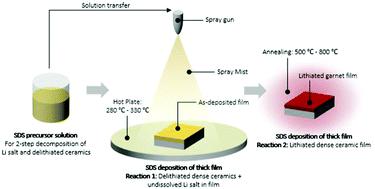当前位置:
X-MOL 学术
›
Energy Environ. Sci.
›
论文详情
Our official English website, www.x-mol.net, welcomes your
feedback! (Note: you will need to create a separate account there.)
A sinter-free future for solid-state battery designs
Energy & Environmental Science ( IF 32.4 ) Pub Date : 2022-06-10 , DOI: 10.1039/d2ee00279e Zachary D. Hood 1 , Yuntong Zhu 1 , Lincoln J. Miara 1, 2 , Won Seok Chang 1, 3 , Philipp Simons 1 , Jennifer L. M. Rupp 1, 4
Energy & Environmental Science ( IF 32.4 ) Pub Date : 2022-06-10 , DOI: 10.1039/d2ee00279e Zachary D. Hood 1 , Yuntong Zhu 1 , Lincoln J. Miara 1, 2 , Won Seok Chang 1, 3 , Philipp Simons 1 , Jennifer L. M. Rupp 1, 4
Affiliation

|
Ceramic-based solid electrolytes and separators are particularly attractive for use in next-generation batteries as a way to increase the electrochemical stability window and improve safety. However, batteries with higher energy densities require thin membranes comparable in thickness to the polymer separators (e.g., 10–25 μm) found in today's Lithium-ion batteries. To date, conventional ceramic–electrolyte processing routes have not been able to achieve this goal as they typically operate on the principle of sintering: going from particle to a densified ceramic body. To overcome this challenge, we provide a blueprint for an alternative cost-effective sequential decomposition synthesis (SDS) approach that uniquely accesses the thickness range required from solid Li oxide-based electrolytes close to those of today's polymer separators and offers immense opportunities for to obtain the desired phase at significantly lower processing temperatures (<700 °C) with unique ceramic microstructures. We specifically highlight the SDS processing of Li garnets and disclose basic SDS precursor and ceramic processing concepts that can be adapted to other Li-containing oxides.
中文翻译:

固态电池设计的无烧结未来
作为增加电化学稳定性窗口和提高安全性的一种方式,基于陶瓷的固体电解质和隔膜特别适合用于下一代电池。然而,具有更高能量密度的电池需要厚度与聚合物隔膜相当的薄膜(例如, 10–25 μm) 在当今的锂离子电池中发现。迄今为止,传统的陶瓷-电解质加工路线无法实现这一目标,因为它们通常按照烧结原理进行操作:从颗粒到致密的陶瓷体。为了克服这一挑战,我们为另一种具有成本效益的顺序分解合成 (SDS) 方法提供了蓝图,该方法独特地获得了与当今聚合物隔膜接近的固体氧化锂基电解质所需的厚度范围,并提供了巨大的机会来获得在显着较低的加工温度 (<700 °C) 下获得所需的相,并具有独特的陶瓷微结构。
更新日期:2022-06-10
中文翻译:

固态电池设计的无烧结未来
作为增加电化学稳定性窗口和提高安全性的一种方式,基于陶瓷的固体电解质和隔膜特别适合用于下一代电池。然而,具有更高能量密度的电池需要厚度与聚合物隔膜相当的薄膜(例如, 10–25 μm) 在当今的锂离子电池中发现。迄今为止,传统的陶瓷-电解质加工路线无法实现这一目标,因为它们通常按照烧结原理进行操作:从颗粒到致密的陶瓷体。为了克服这一挑战,我们为另一种具有成本效益的顺序分解合成 (SDS) 方法提供了蓝图,该方法独特地获得了与当今聚合物隔膜接近的固体氧化锂基电解质所需的厚度范围,并提供了巨大的机会来获得在显着较低的加工温度 (<700 °C) 下获得所需的相,并具有独特的陶瓷微结构。











































 京公网安备 11010802027423号
京公网安备 11010802027423号